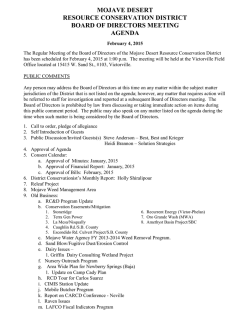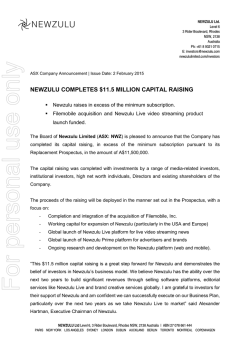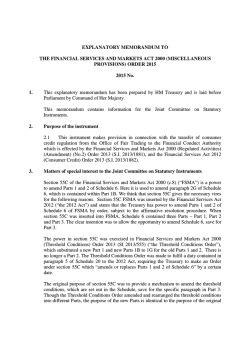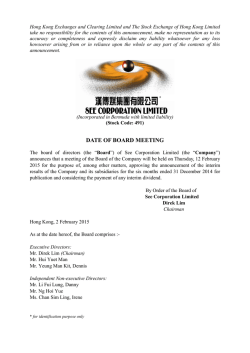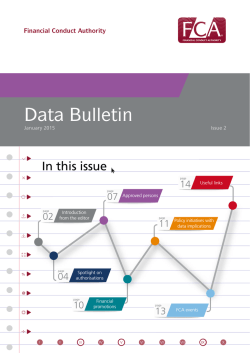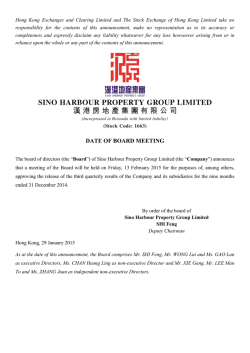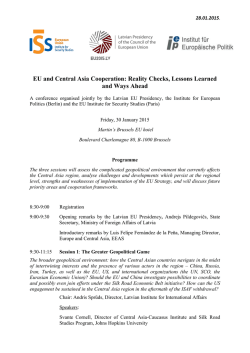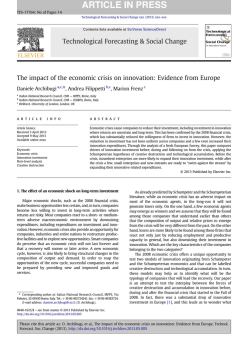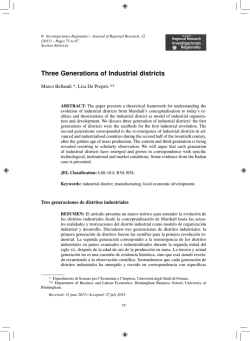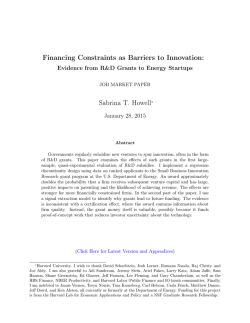
The involvement of board of directors and institutional
Journal of International Management 4 (1998) 337–351 The involvement of board of directors and institutional investors in investing in transition economies: An agency theory approach Laszlo Tihanyi a,*, Alan E. Ellstrand b a Department of Management, School of Business Administration and Economics, California State University, Fullerton, CA 92834, USA b Department of Management and Human Resource Management, College of Business Administration, California State University, Long Beach, CA 90840, USA Abstract We investigate the influence of the composition of the board of directors and stock ownership patterns on the decision to enter markets in Central and Eastern Europe. Our findings suggest that board composition alone does not influence the entry decision while firms with less concentrated stock ownership were more likely to enter these developing markets. We also found that while better performing firms were attracted to opportunities in Central and Eastern Europe, firms with poor prior performance and outside dominated boards were also more likely to enter these markets. © 1999 Elsevier Science Inc. All rights reserved. Keywords: Corporate governance; Central and Eastern Europe; Transition economies; Board of directors Using an agency theory perspective, we investigate the influence of key corporate governance mechanisms on the decision to enter markets of Central and Eastern Europe. We suggest a series of hypotheses to explore the relationship between the composition of the board of directors, the level of institutional stock ownership and management’s decision to invest in the transition econonmies of Central and Eastern Europe. Our sample consisted of 133 firms selected at random from the 1991 Fortune 500. We used binary logit analysis to analyze our data. Our findings suggest that board composition alone does not influence the decision to enter the markets in Central and Eastern Europe. However, we found that poorly performing firms with outsider-dominated boards were more likely to enter the Central and Eastern European markets. In addition, our results suggest that firms with less concentrated stock ownership * Corresponding author. Tel: 714-278-4555; Fax: 714-278-2645; E-mail: [email protected]. 1075-4253/98/$–see front matter © 1999 Elsevier Science Inc. All rights reserved. PII: S1075-4253(98)00019-2 338 L. Tihanyi, A.E. Ellstrand/Journal of International Management 4 (1998) 337–351 also were more likely to enter these developing markets. Our results provide some support for the agency theory perspective in this international context. We offer suggestions for further research in this area. 1. Introduction The opportunities and risks associated with international expansion have been of interest to researchers in international business (Rugman, 1981; Hennart, 1982; Grant, 1987; Dunning 1988; McKiernan 1992; Mitchell et al., 1992; Caves 1996). Numerous studies have found that investments in developing countries are associated with greater levels of uncertainty (e.g., Root and Ahmed, 1978; Sabi, 1988; Collins, 1990). Since the late 1980s, the developing countries of Central and Eastern Europe have been making the transition from centrally planned to market economies. This has created numerous opportunities for businesses interested in investing in the region (Lavigne, 1995; Lyles and Salk, 1996; Brouthers and Bamossy, 1997; De Castro and Uhlenbruck, 1997). However, the expansion into these newly developing markets has often been accompanied by significant risks to multinational firms (Collins and Rodrik, 1991; Welfens, 1992; Froot, 1994). The potential for success or failure resulting from expansion into the highly volatile environments of transition economies may generate interest and possibly conflict among key stakeholders of the firm. The agency theory perspective has been found to be an appropriate framework to examine the possible effects of various stakeholder groups on important strategic decisions (e.g, Jensen and Meckling, 1976; Fama and Jensen, 1983; Eisenhardt, 1989). Agency theory has been applied to study various research issues in the international management field, such as international trade (Mirus and Yeung, 1986), international joint ventures (Reuer and Miller, 1997), international franchise operations (Fladmoe-Lindquist and Jacque, 1995), and foreign subsidiary management (Roth and O’Donnell, 1996). However, little research has focused on the agency problem associated with firm internationalization. The purpose of this article is to examine the influence of key governance mechanisms such as boards of directors and institutional investors on international expansion into the transition economies of Central and Eastern Europe. 2. Background and hypothesis development When considering expansion into new international markets, firms are seeking opportunities that may lead to enhanced profitability and growth (Dunning, 1988; Loree and Guisinger, 1995; Caves, 1996). However, empirical research regarding the results of international expansion has provided mixed results. Michel and Shaked (1986) found higher performance for domestic firms than for multinational firms. Collins (1990) reported that multinational firms with developing country operations had lower performance than domestic firms and multinationals with developed country operations. However, this study did not find performance differences between the last two groups. By contrast, studies by Hughes et al. (1975) and Kim et al. (1993) found that multinational corporations had higher performance than domestic firms. Geringer et al. (1989) identified a curvilinear relationship between international expansion and firm performance. These researchers suggest that this relationship may be due L. Tihanyi, A.E. Ellstrand/Journal of International Management 4 (1998) 337–351 339 to escalating costs related to geographic dispersion. A recent study by Hitt et al. (1997) found support for the findings of Geringer et al. (1989). These researchers argue that the eventual performance decline may be due to the increased complexity of international operations. Because of the potential opportunities and threats associated with international expansion, managers must consider several factors before committing resources to enter new markets. For example, developing markets may provide a source of low-cost labor and large numbers of consumers whose needs may not be met by existing businesses. Thus, these markets may provide attractive opportunities for any firm willing to face the risks associated with entering these markets. Nevertheless, the risks associated with entering developing markets also may be significant as these markets may be politically and economically unstable, with high currency exchange risk, high inflation, and inadequate infrastructure for business development (Root and Ahmed, 1978; Sabi, 1988). The political events of the late 1980s lead to significant reforms in the economies of the Central and Eastern European nations. These nations had operated as centrally planned economies with governments establishing price and production levels after World War II (Gomulka, 1986; Bergson, 1989; Kornai, 1992). With the political and economic changes of the late 1980s, nations in Central and Eastern Europe began the transition to market-based economic systems (Kornai, 1990; Blanchard et al., 1991; Montias, 1992; Antal-Mokos, 1998). While local citizens as well as outside interests initially received the reforms with much hope and enthusiasm, the transition has proven to be a complicated process for many countries in the region (Olson, 1992; Portes, 1993). Whereas some countries have been relatively successful at introducing the economic reforms necessary to establish consumer markets, other nations have encountered significant resistance to installing market reforms. The short-term outcome of the transition is a diverse group of countries with differing political views, government policies and varying levels of economic development (Welfens, 1992; Marer, 1993; Lavigne, 1995). Multinational firms entering Central and Eastern Europe have found that the experience has not always met expectations. A study on initial attitudes toward investing in the transition economies of Eastern Europe by Collins and Rodrik (1991) found that multinational companies focused primarily on beating their competitors and being first entrants in the region’s markets. However, multinational companies have gradually reduced their expectations due to the difficulties they have encountered in establishing local operations and the uncertain status and direction of government economic transformation programs (Froot, 1994). De Castro and Uhlenbruck (1997) suggest that difficulties associated with government regulation in transition economies are more likely to include post-privatization requirements such as assurances of new investment, tax policies, and price controls, than in other developing countries. While existing research has focused on motivations for entry into this region, our study seeks to understand the role of the corporate governance process in approving entry into this potentially rewarding but uncertain market. Specifically, we examine the influence of corporate governance mechanisms—board of directors’ composition and institutional stock ownership on entry into the Central and Eastern European market. The board of directors is positioned at the top of the corporate governance structure of the modern business corporation (Lorsch and MacIver, 1989). While the board serves many important governance functions, one of its key roles is that of providing oversight and control over the decisions of top management (Zahra and Pearce, 1989; Pearce and Zahra, 1992). In this control function, the board of directors is responsible for monitoring the strategic deci- 340 L. Tihanyi, A.E. Ellstrand/Journal of International Management 4 (1998) 337–351 sions of top corporate executives including international expansion decisions. (Andrews, 1971; Demb et al., 1989). In the modern business corporation, small corporate investors (owners) are far removed from corporate decision makers. This separation of ownership and control may leave shareholders vulnerable to two agency problems (Fama and Jensen, 1983; Eisenhardt, 1989). First, managers may have different goals for the corporation than shareholders. Managers may be primarily concerned with reward maximization and job security while investors may be seeking the highest possible returns. A second conflict may result from differing attitudes toward risk. Because shareholders can diversify their investment portfolios they may be attracted to high-risk/high-return opportunities. However, managers may be reticent to pursue high-risk projects due to the potential for failure, which creates employment risk for these executives (Jensen and Meckling, 1976). Agency theorists suggest that the board of directors is in place to monitor and interpret the decisions of top managers and possibly intervene on behalf of shareholders. The composition of the board of directors is a critical factor in establishing the effectiveness of the board as an objective monitor of management (Fama and Jensen, 1983). Board composition refers to the relative numbers of inside (management) and outside (nonmanagement) directors serving on the board. Agency theorists suggest that boards dominated by inside directors may be less vigilant monitors of management as these directors may intentionally provide self-serving accounts of managerial actions to enhance their status with the firm’s chief executive officer (Fama, 1980; Eisenhardt, 1989). By contrast, outside directors are thought to be vital in ensuring that an effective, impartial governance system is allowed to operate within the corporation since outside directors have more independence from management (Fama, 1980). Johnson et al. (1993) suggest that outsider-dominated boards, because of their greater objectivity in evaluating firm performance, will be inclined to support higher risk but potentially more rewarding strategies. These boards may support internationalization decisions that result in entry into the emerging markets of Central and Eastern Europe. The region includes a large number of consumers, a skilled but relatively low-cost labor force, and many industrial centers, when compared with other developing countries. These opportunities have attracted multinational companies to invest over $18 billion in Central and Eastern Europe during the period 1990 to 1995. Emphasizing the opportunities available in Central and Eastern Europe, De Castro and Uhlenbruck (1997) note that these countries are less likely to impose restrictions on investments, such as local ownership and employment requirements, than less-developed countries. This is may be due to the capital inflow and hard currency needs of the governments of transition economies. However, firms entering this region have found a great deal of economic and political instability in the wake of the major changes that transformed the region a decade ago. Corporate shareholders may not be concerned about these potential risk factors because they have the opportunity to reduce risk through portfolio diversification. Thus, these shareholders may favor companies that invest in these emerging markets based on their potential for significant growth and increased profits. Outsider-dominated boards tend to support the interests of shareholders over management. Therefore, H1: Boards with a majority of outside directors will support strategies that lead to entry into the markets of Central and Eastern Europe. L. Tihanyi, A.E. Ellstrand/Journal of International Management 4 (1998) 337–351 341 While the board of directors may be a necessary and effective mechanism for protecting the interests of small investors, large institutional shareholders, who control more than onehalf of America’s corporate equity, may prefer to present their concerns directly to corporate management (Salwen and Lublin, 1992.). While there are various theories on the level of activism among institutions, Kochhar and David (1996) identify large institutions that take a long-term perspective in their investments as “superior investors” and “active investors.” These investors may be unable to freely trade large blocks of corporate equity as such sales may trigger concern in the investment community, leading to significant price declines (Coffee, 1991; Cox, 1993). As a result, these large institutions must carefully consider investments for opportunities that will provide significant long-term returns (Kochhar and David, 1996). These shareholders have the resources to employ analysts who monitor and evaluate the actions of corporate management. As they gain stature in the corporate community, these large, influential shareholders are insisting on a greater role in the governance of corporations (Oviatt, 1988). Because of their “illiquidity” problem these institutional investors may look for and even encourage investments by firms that will lead to higher returns over the long term while also increasing the level of risk (Johnson and Millon, 1993; Kochhar and David, 1996). Therefore, entry into the emerging markets of Central and Eastern Europe may present an attractive long-term strategic opportunity for institutional equity managers. As a result, H2: Corporations whose equity is held in the majority by large, institutional shareholders will be more likely to enter the markets of Central and Eastern Europe. As previously discussed, there is substantial empirical evidence to suggest that internationalization affects firm performance (e.g., Michel and Shaked, 1986; Geringer et al., 1989; Dunning, 1993; Caves, 1996; Hitt et al., 1997). However, little is known about the influence of prior performance on internationalization decisions. Empirical work in strategic management suggests that prior performance may have a significant influence on organizational actions (Whetten, 1987; Boeker and Goodstein, 1991). Studies have shown that better performing firms are more open to expansion and uncertainty (Child and Kieser, 1981; Dutton and Duncan, 1987) and are more likely to increase their international involvement (Patterson et al., 1997). Researchers also have found that poor performance increases rigidity and conservatism reducing the probability of organizational action (Staw et al., 1981; Singh, 1986). Based on these findings, we expect that poor performing firms will be less likely to expand into the transition economies of Central and Eastern Europe. Researchers note, that when prior performance is poor, changes are more likely to be initiated by outsiders, rather than executives inside the company (Dalton and Kesner, 1985). Firms reporting poor performance that have boards dominated by outside directors may be more sensitive to the need to adopt bold policies that may lead to significant change including entry into new international markets (Johnson et al., 1993). By contrast, those firms reporting higher levels of performance with boards dominated by insiders may take a more conservative approach. The level of institutional stock ownership also may interact with prior firm performance to significantly influence a firm’s strategic decisions. Firms reporting poor performance that have high levels of institutional ownership may be pressured by these activist owners to 342 L. Tihanyi, A.E. Ellstrand/Journal of International Management 4 (1998) 337–351 change the strategic direction of the firm to improve corporate performance. These firms may be inclined to enter new markets to improve performance (Kochhar and David, 1996). By contrast, those firms reflecting lower levels of performance with less concentrated equity holdings may be more likely to avoid strategic change. Thus, H3a: Firms reporting poor prior performance will be less likely to enter the Central and Eastern European market. H3b: Firms with poor prior performance and boards with a majority of outsiders will be more likely to enact strategies that lead to entry into the markets of Central and Eastern Europe than firms with poor performance and insiders dominated boards. H3c: Firms with poor prior performance whose equity is held in the majority by large, institutional shareholders will be more likely to support strategies that lead to entry into the markets of Central and Eastern Europe than firms with poor performance and diffused ownership structure. 3. Methods Our original sample included 150 firms selected at random from the Fortune 500 for 1991. From this sample of 150, we excluded those firms with existing investments in Central and Eastern Europe prior to the initiation of the transition in 1989. In addition, firms with missing governance data also were removed from our sample. As a result our final sample consisted of 133 firms. Data for our dependent variable, the firms’ investments in the transition economies of Central and Eastern Europe, were collected from volumes of the Directory of American Firms Operating in Foreign Countries from 1991 to 1996. The Directory includes listings of overseas companies that have been identified by the parent firms as being a wholly or partially owned subsidiary, an affiliate, or a branch. Firms were coded “1” if they had made investment in the transition economies of Central and Eastern Europe, and “0” otherwise. Countries in this study included the former communist countries of Central and Eastern Europe, including countries comprising the former Soviet Union, its satellites, and the former Yugoslavia (Child and Czeglédy, 1996; De Castro and Uhlenbruck, 1997). Institutional investors. Data on the firms’ ownership were coded as “1” if the ownership of the firm was concentrated (when the majority of the stock was held by institutional investors) and “0” in case of diffused ownership (when the majority of ownership was divided among other equity holders). We chose to use a dichotomous measure in this case to capture the influence of majority institutional ownership. This information was gathered from the CD Disclosure database. Board composition. Board composition was coded as “1” when the majority of board members were outsiders (nonemployees) and “0” when the majority of the board members were insiders. We selected a dichotomous measure for this variable as we wanted to capture the decision-making influence associated with outside directors holding a voting majority on the board. Data on board structure and stock ownership were collected from proxy statements. L. Tihanyi, A.E. Ellstrand/Journal of International Management 4 (1998) 337–351 343 3.1. Prior performance The measurement of prior performance was based on the firms’ average return on investment (ROI) from 1988 to 1990. ROI was collected from the COMPUSTAT database. Using the ROI data, we created three categories based on the distribution of the data: poor, fair, and good performers. We chose to categorize performance into three equal groups as we hypothesized that governance agents including directors and institutional investors would assign firm performance into general categories when making governance decisions. 4. Results The descriptive statistics and correlations are reported in Table 1. Because of the binomial distribution generated by our dependent variable, data analysis was completed by using binary logit analysis in SPSS Loglinear. The maximum likelihood estimation used in logit analysis is concerned with selecting parameter estimates that imply the highest probability of having obtained the observed sample dependent variable (Maddala, 1983; Aldrich and Nelson, 1984). The saturated model is presented in Table 2. This full model in SPSS Loglinear is used to illustrate the variables whose parameters differ significantly from zero, that is, when any of the partial Z-tests of a variable is significant (Norusis, 1990; Stevens, 1992). According to the Z-tests presented in Table 2, institutional investors, prior performance, and the interaction of prior performance and board structure are significant (p Ͻ 0.05), with the individual confidence intervals of significant parameters not covering zero. The logit model presented in Table 3 includes only the significant effects. This more parsimonious logit model is specified as shown in Eq. (1): log O invest = β int + β x i + β x j + β x I I P P PB PB (1) jk . where logOinvest is the log odds of investment in transition economies, int is the intercept, I, P, and PB are the parameter estimates for institutional investors (xIi), prior performance (xPj), and the interactive effect of prior performance and board structure (x PBjk), respectively. This model can be transformed into a logit model of event probability (e.g., Liao, 1994), where Pinvest denotes the probability of investment in transition economies as shown in Eq. 2: P invest = exp ( β int + β x i + β x j + β x I I P P PB PB jk ) ( 1 + exp ( β int + β x i + β x j + β x I I P P ⁄ PB PB jk ) ) . (2) Table 1 Descriptive statistics and correlations among the variables Investment in transition economies Institutional investors Board of directors Prior performance * Significant at p Ͻ 0.05. Mean Standard deviation 1 2 3 0.21 0.74 0.65 1.90 0.41 0.44 0.48 0.91 Ϫ0.194* Ϫ0.081 0.076 0.130 0.030 Ϫ0.010 344 L. Tihanyi, A.E. Ellstrand/Journal of International Management 4 (1998) 337–351 Table 2 Results of logit analysis Intercept Institutional investors Diffused Concentrated Prior performance Poor Fair Good Board structure Insider Outsider Prior performance* Institutional investors Poor Diffused Concentrated Fair Diffused Concentrated Good Diffused Concentrated Institutional investors * Board structure Diffused Insider Outsider Concentrated Insider Outsider Prior performance* Board structure Poor Insider Outsider Fair Insider Outsider Good Insider Outsider  exp() Z-tests Ϫ0.946 0.388 Ϫ3.568* 0.546 Ϫ0.546 1.726 0.579 2.061* Ϫ2.061* Ϫ0.742 0.642 0.100 0.476 1.900 1.105 Ϫ1.960* 1.566 0.256 0.174 Ϫ0.174 1.190 0.840 0.652 Ϫ0.652 0.236 Ϫ0.236 1.266 0.790 0.623 Ϫ0.623 Ϫ0.240 0.240 0.787 1.271 Ϫ0.589 0.589 0.004 Ϫ0.004 1.004 0.996 0.010 Ϫ0.010 Ϫ0.028 0.028 0.972 1.028 Ϫ0.103 0.103 0.028 Ϫ0.028 1.028 0.972 0.103 Ϫ0.103 Ϫ0.974 0.974 0.378 2.649 Ϫ2.574* 2.574* 0.682 Ϫ0.682 1.978 0.506 1.669† Ϫ1.669† 0.292 Ϫ0.292 1.339 0.747 0.749 Ϫ0.749 (continued on next page) L. Tihanyi, A.E. Ellstrand/Journal of International Management 4 (1998) 337–351 345 Table 2 (continued) Prior performance* Institutional investor* Board structure Poor Diffused Insider Outsider Concentrated Insider Outsider Fair Diffused Insider Outsider Concentrated Insider Outsider Good Diffused Insider Outsider Concentrated Insider Outsider  exp() Z-tests 0.124 Ϫ0.124 1.132 0.883 0.327 Ϫ0.327 Ϫ0.124 0.124 0.883 1.132 Ϫ0.327 0.327 0.270 Ϫ0.270 1.310 0.763 0.662 Ϫ0.662 Ϫ0.270 0.270 0.763 1.310 Ϫ0.662 0.662 Ϫ0.394 0.394 0.674 1.483 Ϫ1.010 1.010 0.394 Ϫ0.394 1.483 0.674 1.010 Ϫ1.010 Saturated model. n ϭ 133. * Significant at p Ͻ 0.05; † Significant at p Ͻ 0.10. The analysis presented in Table 2 indicates that the individual effect of board structure was not significant, thus hypothesis 1 was not supported. Results indicate a significant effect for the variable institutional investors although the result was in the opposite direction suggested by hypothesis 2. More specifically, the results of the final logit model indicate that for firms with a majority of noninstitutional ownership the odds of investing in transition economies are estimated to be 1.811 times higher than for firms with majority institution ownership, ceteris paribus. According to our analysis, prior firm performance had a significant individual effect on the dependent variable. Results show a decreased chance of investing in transition economies (0.344) for firms with poor prior performance when compared to other firms. For firms with fair prior performance the odds of investing in transition economies are 2.363 higher than for other firms. As a result, hypothesis 3a is supported. Significant effects were found for the interaction term of prior performance and board structure, providing support for hypothesis 3b. We found that firms with poor prior performance and insider board structure have decreased odds of investing in transition economies (0.267) when compared to firms with similar performance but with different board structure. For firms with poor performance and outsider boards the likelihood of investing in transition 346 L. Tihanyi, A.E. Ellstrand/Journal of International Management 4 (1998) 337–351 Table 3 The effects of institutional investors, prior performance, and prior performance* board structure on investing in transition economies Intercept Institutional investors Diffused Concentrated Prior performance Poor Fair Good Prior performance* board structure Poor Insider Outsider Fair Insider Outsider Good Insider Outsider Goodness-of-fit statistics Likelihood ratio chi-square Pearson chi-square Measures of association Shannon’s entropy measure Gini’s concentration measure  exp() Z-tests Ϫ1.168 0.311 Ϫ4.308* 0.594 Ϫ0.594 1.811 0.552 2.406* Ϫ2.406* Ϫ1.068 0.860 0.208 0.344 2.363 1.231 Ϫ2.524* 2.101* 0.507 Ϫ1.320 1.320 0.267 3.743 Ϫ2.858* 2.858* 0.810 Ϫ0.810 2.248 0.445 1.879† Ϫ1.879† 0.510 Ϫ0.510 1.665 0.600 1.159 Ϫ1.159 df ϭ 6 df ϭ 6 p ϭ 0.649 p ϭ 0.677 4.203 3.995 0.137 0.140 n ϭ 133. Results are from the final logit model. * Significant at p Ͻ 0.05; † Significant at p Ͻ 0.10. economies is estimated to be 3.743 higher than for firms with poor performance but insider board structure. The final model indicates a marginally significant effect for the parameter estimates of the interaction of fair performance and board structure. However, we found no significant effect for the interaction between prior performance and institutional investors, thus hypothesis 3c was rejected. The goodness-of-fit tests indicate that the final model fits the observed data well, with a likelihood ratio chi-square of 4.203 (df ϭ 6; p ϭ 0.649). The concentration coefficient of the final model is 0.14. This measure indicates the association between our dependent variable and the independent variables in the final model (DeMaris, 1992). However, researchers suggest that the magnitude of this measure maybe small even when the variables are strongly related, therefore the magnitude should not be interpreted similarly to R2 in regression (Haberman, 1982; Aldrich and Nelson, 1984). Tansey et al. (1996) recommended the use of multiple techniques when analyzing categorical data. We performed a logistic regression procedure as a secondary analysis to ensure the robustness of our analysis. The results of the logistic regression validated our loglinear analysis. These results are presented in Table A1 in the Appendix. L. Tihanyi, A.E. Ellstrand/Journal of International Management 4 (1998) 337–351 347 5. Discussion Using an agency theory perspective, we examined the relationship between board composition, ownership structure, and the strategic decision to enter the transition economies of Central and Eastern Europe in the early 1990s. We also investigated the effects of firm performance in this situation. Our results indicate some support for our contention that these governance variables have a significant influence on the decision to enter the transition economies. We did not find a significant relationship between board composition and entry into the transition economies of Central and Eastern Europe except when firm performance was considered. This may suggest that the decision to enter the transition economies in the early 1990s was a complex one that was not determined based on traditional attitudes toward risk and reward. It is also possible that directors, regardless of background, were not directly involved in this decision. Rather, these directors may have deferred to the top management team and simply approved their decision. Researchers should focus more attention on the role of the board of directors in this situation to better understand the dynamics between the board and top management in arriving at this important strategic decision. Contrary to our hypothesis, we found that firms with lower levels of institutional ownership were more inclined to enter the Central and Eastern European markets. It is possible that entry into the transitional economies may represent an unacceptable level of risk for institutional investors. The results may also suggest that the opportunities for long-term returns, as suggested by Kochhar and David (1996), are viewed as uncertain in transition economies by “active institutional investors.” Thus, institutions may discourage firms from entering this region. Clearly, more research should be conducted to better understand this relationship. We found that firm performance did influence the decision to enter the transition economies of Central and Eastern Europe. Our findings suggest that middle range performers were most likely to enter these emerging markets. This might indicate that firms may be reluctant to engage in risk-taking behavior when performance is good. In addition, poor performers may lack the resources or the necessary firm-specific advantages to engage in a major strategic initiative such as entering speculative new markets. Thus, the middle range performers have both the motive and resources to enter these markets. This outcome is consistent with previous work exploring motives concerning risk and returns in the strategic management literature (Fiegenbaum and Thomas, 1988). While we did not find a significant interaction between firm performance and institutional ownership, we did find a significant interaction between firm performance and board composition. As expected, when corporations are performing poorly, those firms with boards dominated by outsiders are more likely to accept the risk to invest in transitional economies. This supports the position that outside directors become especially vigilant in representing shareholders interests only when firms are experiencing performance difficulties (Johnson et al., 1993). When performance is good, directors may not feel compelled to encourage risk-taking behavior. Our study found that, under certain circumstances, corporate executives may be sensitive to the presence of directors and shareholders when making important strategic decisions concerning entry into risky new markets. This study is only a first step in attempting to under- 348 L. Tihanyi, A.E. Ellstrand/Journal of International Management 4 (1998) 337–351 stand the complex processes involved in evaluating and selecting new markets and determining the role that governance mechanisms play in this strategic decision. For example, this study focused on the entry decisions of large U.S. based multinational companies into transition economies. The agency theory perspective was found to be relevant to analyze this population. However, researchers have noted that agency theory may not be generalizable to other populations of firms from different cultures. For example, Sharp and Salter (1997) found that agency theory has very weak explanatory power in collectivist countries including some Asian nations. Additionally, Antal-Mokos (1998) suggests that the agency theory perspective may have shortcomings in explaining the privatization process in transition economies. Future research needs to devote more attention to these and other complex issues involved in arriving at decisions related to international expansion. 6. Conclusion Our study represents an initial attempt at investigating the role of the corporate governance process in international investment decisions. We found support for our contention that the composition of the board of directors and level of institutional ownership may have an influence on the decision to invest in transition economies under certain circumstances. However, this support was not uniform across all variables in our study. The results of this study may hold some implications for business practitioners. Our findings may indicate that corporate directors and institutional investors show some concern about the international investment decisions of their firms, at least when firms are performing poorly. Thus, corporate managers should be prepared to work with these stakeholders in order to gain support for these important international investment decisions. Future research should be conducted to gain a better understanding of the role of governance agents in these important internationalization decisions. Acknowledgments The authors gratefully acknowledge the helpful comments and suggestions of three anonymous reviewers. References Aldrich, J.H., Nelson, F.D., 1984. Linear probability, logit, and probit models. Sage, Thousand Oaks, CA. Andrews, K.R., 1971. The concept of corporate strategy. Irwin, Homewood, IL. Antal-Mokos, Z., 1998. Privatisation, politics and economic performance in Hungary. Cambridge University Press, Cambridge, UK. Bergson, A., 1989. Planning and performance in socialist economies. Unwin Hyman, Inc., Boston. Blanchard, O.J., Dornbusch, R., Krugman, P., Layard, R., Summers, L., 1991. Reform in Eastern Europe. The MIT Press, Cambridge, MA. Boeker, W., Goodstein, J., 1991. Organizational performance and adaptation: effects of environment and performance on changes in board composition. Acad Manage J 34, 805–826. L. Tihanyi, A.E. Ellstrand/Journal of International Management 4 (1998) 337–351 349 Brouthers, K.D., Bamossy, G.J., 1997. The role of key stakeholders in international joint venture negotiations: case studies from Eastern Europe. J Int Business Stud 28 (2), 285–308. Caves, R.E., 1996. Multinational enterprise and economic analysis. Cambridge University Press, Cambridge, UK. Child, J., Czeglédy, A.P., 1996. Managerial learning in the transformation of Eastern Europe: some key issues. Organ Stud 17 (2), 167–179. Child, J., Kieser, J., 1981. Development of organizations over time. In: Nystrom, P., Starbuck, W. (Eds.), Handbook of organizational design. Oxford University Press, Oxford. Coffee, J.C., 1991. Liquidity versus control: the institutional investor as corporate monitor. Columbia Law Rev 91 (6), 1277–1368. Collins, J. M., 1990. A market performance comparison of U.S. firms active in domestic, developed and developing countries. J Int Business Stud 2, 271–287. Collins, S.M., Rodrik, D., 1991. Eastern Europe and the Soviet Union in the world economy. Institute for International Economics, Washington, DC. Cox, J.D., 1993. The ALI, institutionalizaton, and disclosure: the quest for the outside director’s spine. George Washington Law Rev 61, 1233–1273. Dalton, D.R., Kesner, I.F., 1985. Organizational performance as an antecedent of inside/outside chief executive succession: an empirical assessment. Acad Manage J 28, 749–762. De Castro, J.O., Uhlenbruck, K., 1997. Characteristics of privatization: evidence from developed, less-developed, and former communist countries. J Int Business Stud 28 (1), 123–143. DeMaris, A., 1992. Logit modeling: practical applications. Sage, Thousand Oaks, CA. Demb, A., Chouet., D., Lossius, T., Neubauer, F., 1989. Defining the role of the board. Long Range Planning 22, 61–68. Dunning, J.H., 1988. Explaining international production. Unwin Hyman, London. Dunning, J.H., 1993. Multinational enterprises and the global economy. Addison-Wesley, Wokingham, England. Dutton, J., Duncan, R., 1987. The creation of momentum for change through the process of strategic issue diagnosis. Strategic Manage J 8, 279–295. Eisenhardt, K.M., 1989. Agency theory: An assessment and review, Acad Manage Rev 14 (1), 57–74. Fama, E.F., 1980. Agency problems and the theory of the firm. J Political Econ 26, 288–307. Fama, E.F., Jensen, M.C., 1983. Separation of ownership and control. J Law Econ 26, 301–343. Fiegenbaum, A., Thomas, H., 1988. Attitudes toward risk and the risk-return paradox: prospect theory explanations. Acad Manage J 31, 85–106. Fladmoe-Lindquist, K., Jacque, L.L., 1995. Control modes in international service operations: the propensity to franchise. Manage Sci 41 (7), 1238–1249. Froot, K.A., 1994. Foreign direct investment in Eastern Europe: some economic considerations. In: Blanchard, O.J., Froot, K.A., Sachs, J.D. (Eds.), The transition in Eastern Europe. The University of Chicago Press, Chicago. Geringer, J.M., Beamish, P.W., daCosta, R.C., 1989. Diversification strategy and internationalization: implications for MNE performance. Strategic Manage J 10, 109–119. Gomulka, S., 1986. Growth, innovation and reform in Eastern Europe. Wheatsheaf Books Ltd, Brighton, UK. Grant, R.M., 1987. Multinationality and performance among British manufacturing companies. J Int Business Stud 18, 79–86. Haberman, S.J., 1982. Analysis of dispersion of multinomial responses. J Am Stat Assoc 77, 568–580. Hennart, J.F., 1982. A theory of multinational enterprise. University of Michigan Press, Ann Arbor, MI. Hitt, M.A., Hoskisson, R.E., Kim, H., 1997. International diversification: effects on innovation and firm performance in product-diversified firms. Acad Manage J 40, 767–798. Hughes, J., Longue, D., Sweeney, R., 1975. Corporate international diversification and market assigned measures of risk and diversification. J Financial Quant Analysis (November), 627–637. Jensen, M.C., Meckling, W., 1976. Theory of the firm: managerial behavior, agency costs, and ownership structure. J Financial Econ 11, 305–360. Johnson, L., Millon, D., 1993. Corporate takeovers and corporate law: who’s in control? George Washington Law Rev 61, 1177–1211. Johnson, R.A., Hoskisson, R.E., Hitt, M.A., 1993. Board of director involvement in restructuring: the effects of board versus managerial controls and characteristics. Strategic Manage J 14, 33–50. 350 L. Tihanyi, A.E. Ellstrand/Journal of International Management 4 (1998) 337–351 Kim, W.C., Hwang, P., Burgers, W.P., 1993. Multinationals’ diversification and the risk-return trade-off. Strategic Manage J 14, 275–286. Kochhar, R., David, P., 1996. Institutional investors and firm innovation, a test of competing hypotheses. Strategic Manage J 17, 73–84. Kornai, J., 1990. The road to a free economy. W.W. Norton and Company, New York. Kornai, J., 1992. The socialist system. Princeton University Press, Princeton, NJ. Lavigne, M., 1995. The economics of transition. St. Martin’s Press, New York. Liao, T.F., 1994. Interpreting probability models: logit, probit, and other genaralized linear models. Sage, Thousand Oaks, CA. Loree, D.W., Guisinger, S.E., 1995. Policy and non-policy determinants of U.S. equity foreign direct investment. J Int Business Stud 26 (2), 281–299. Lorsch, J.W., MacIver, E., 1989. Pawns or potentates: the reality of America’s corporate boards. Harvard Business School Press, Boston. Lyles, M.A., Salk, J.E., 1996. Knowledge acquisition from foreign parents in international joint ventures: an empirical examination in the Hungarian context. J Int Business Stud 27 (5), 877–903. Maddala, G.S., 1983. Limited dependent and qualitative variables in econometrics. Cambridge University Press, Cambridge, UK. Marer, P., 1993. Economic transformation in Central and Eastern Europe. In: Islam, S., Mandelbaum, M. (Eds.), Making markets: economic transformation in Eastern Europe and the post-Soviet states. Council on Foreign Relations Press, New York. McKiernan, P., 1992. Strategies of growth: maturity, recovery, and internationalization. Routhledge, London. Michel, A., Shaked, I., 1986. Multinational corporations versus domestic corporations financial performance and characteristics. J Int Business Stud 17 (1), 89–106. Mirus, R., Yeung, B., 1986. Economic incentives for countertrade. J Int Business Stud 17 (3), 27–39. Mitchell, W., Shaver, M., Yeung, B., 1992. Getting there in a global industry: impacts on performance of changing international presence. Strategic Manage J 13, 410–432. Montias, J.M., 1992. On firms, hierarchies, and economic reforms. In: Kovács, J.M., Tardos, M. (Eds.), Reform and transformation in Eastern Europe. Routledge, London. Norusis, M.J., 1990. SPSS advanced statistics user guide. SPSS Inc., Chicago. Olson, M., 1992. The hidden path to successful economy. In: Clague, C., Rausser, G.C. (Eds.), The emergence of market economies in Eastern Europe. Blackwell Publishers, Cambridge, MA. Oviatt, B., 1988. Agency and transaction cost perspectives on the manager-shareholder relationship: incentives for congruent interests. Acad Manage Rev 13, 214–225. Patterson, P.G., Cicic, M., Shoham, A., 1997. A temporal sequence model of satisfaction and export intentions of service firms. J Global Marketing 10 (4), 23–43. Pearce, J.A., Zahra, S.A., 1992. Board composition from a strategic contingency perspective. J Manage Studies 29, 411–438. Portes, R., 1993. From central planning to a market economy. In: Islam, S., Mandelbaum, M., (Eds.), Making markets: economic transformation in Eastern Europe and the post-Soviet states. Council on Foreign Relations Press, New York. Reuer, J.J., Miller, K.D., 1997. Agency costs and the performance implications of international joint venture internationalization. Strategic Manage J 18, 425–438. Root, F.R., Ahmed, A.A., 1978. The influence of policy instruments on manufacturing direct foreign investment in developing countries. J Int Business Stud 9 (3), 81–93. Roth, K., O’Donnell, S., 1996. Foreign subsidiary compensation strategy: an agency theory perspective. Acad Manage J 39, 678–703. Rugman, A.M., 1981. Inside the multinationals: the economics of internal markets. Columbia University Press, New York. Sabi, M., 1988. An application of the theory of foreign direct investment to multinational banking in LDCs. J Int Business Stud 19 (3), 433–447. Sharp, D.J., Salter, S.B., 1997. Project escalation and sunk costs: a test of the international generalizability of agency and prospect theories. J Int Business Studies 28 (1), 101–121. L. Tihanyi, A.E. Ellstrand/Journal of International Management 4 (1998) 337–351 351 Singh, J., 1986. Performance, slack, and risk taking in organizational decision making. Acad Manage J 29, 562– 585. Staw, B.M., Sandelands, L.E., Dutton, J.E., 1981. Threat-rigidity effects in organizational behavior: a multi-level analysis. Administrative Sci Q 26, 501–524. Stevens, J., 1992. Applied multivariate statistics for the social sciences (2nd edition). Lawrence Erlbaum Associates, Hillsdale, NJ. Tansey, R., White, M., Long, R.G., Smith, M., 1996. A comparison of loglinear modeling and logistic regression in management research. J Manage 22 (2), 339–358. Welfens, P.J., 1992. Foreign investment in the East European transition. Manage Int Rev 32 (3), 199–218. Whetten, D. 1987. Organizational growth and decline processes. In: Coleman, J. (Ed.), Annual review of sociology, 13. Annual Reviews, Palo Alto, CA. Zahra, S.A., Pearce, J.A., 1989. Board of directors and corporate financial performance: A review and integrative model. J Manage 15, 291–334. Appendix Table A1 Logistic regression results Constant Institutional investors Prior performance Prior performance* board structure1 Model chi-square Correct classification ϭ 78.2% b SE Wald p Ϫ0.185 Ϫ0.915 0.743 Ϫ0.337 8.324 0.892 0.460 0.385 0.204 df ϭ 3 0.043 3.956 3.736 2.723 0.836 0.047 0.053 0.099 0.040 n ϭ 133. The interaction of prior performance and board structure has been recoded into a separate variable for this analysis. 1
© Copyright 2025
